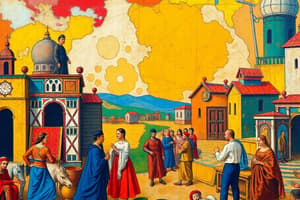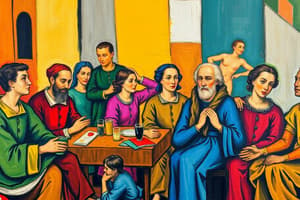Podcast
Questions and Answers
What period does the term 'Renaissance' refer to?
What period does the term 'Renaissance' refer to?
- 20th-21st centuries
- 18th-19th centuries
- 14th-16th centuries (correct)
- 10th-12th centuries
What intellectual movement focused on human potential and achievements during the Renaissance?
What intellectual movement focused on human potential and achievements during the Renaissance?
Humanism
Secular refers to matters pertaining to religion.
Secular refers to matters pertaining to religion.
False (B)
What term describes a person who financially supports the arts?
What term describes a person who financially supports the arts?
What artistic technique creates the appearance of three dimensions on a flat surface?
What artistic technique creates the appearance of three dimensions on a flat surface?
Which family ruled Florence during the Renaissance and spent a lot of money on art?
Which family ruled Florence during the Renaissance and spent a lot of money on art?
A Renaissance Man is someone who knows almost everything about many topics.
A Renaissance Man is someone who knows almost everything about many topics.
Who is known as the 'Father of Humanism'?
Who is known as the 'Father of Humanism'?
What did Machiavelli's 'The Prince' describe?
What did Machiavelli's 'The Prince' describe?
What is the definition of 'Utopia'?
What is the definition of 'Utopia'?
Match the following artists with their notable works:
Match the following artists with their notable works:
Flashcards are hidden until you start studying
Study Notes
Renaissance Overview
- Renaissance marked a cultural rebirth in Europe from the 14th to 16th centuries, transitioning into modern history.
- Humanism emerged as a key intellectual movement, focusing on human potential and achievements.
Key Terms
- Secular: Refers to worldly matters, distinct from religious concerns.
- Patron: Individuals who financially supported artists and the arts during the Renaissance.
- Perspective: An artistic technique for creating a three-dimensional appearance on flat surfaces.
- Vernacular: The everyday language spoken by the common people, as opposed to literary languages.
Influential Families and Figures
- Medici Family: Wealthy banking family that ruled Florence, significantly affecting the Renaissance through art patronage for approximately 300 years.
- Renaissance Man: A well-rounded individual knowledgeable in multiple fields, typical of the era’s scholars.
Renaissance Women
- Upper-class women were expected to know classics and charm but were not pursued for fame, focusing instead on inspiring art rather than creating it.
Notable Artists
- Donatello: Renowned Italian sculptor known for lifelike figures including his bronze statue of David.
- Michelangelo: Artist famous for the Sistine Chapel ceiling and the sculpture of David.
- Leonardo da Vinci: Universal genius recognized for masterpieces like The Last Supper and the Mona Lisa, known for a combination of artistic and scientific pursuits.
- Raphael: Celebrated for divine portrayals of the Virgin Mary and frescoes in the Vatican, including The School of Athens.
- Sofonisba Anguissola: A rare female artist known for capturing families in intimate portraits.
- Artemisia Gentileschi: Notable female painter and member of the Florentine Academy, known for historical and religious works.
Literary Contributions
- Petrarch: Regarded as the "Father of Humanism," he introduced emotion in poetry with "Sonnets to Laura."
- Boccaccio: Wrote "The Decameron," exploring themes of ambition and a worldly society.
- Machiavelli: Authored "The Prince," discussing ethics in governance and the idea that "the end justifies the means."
- Thomas More: Wrote Utopia, describing an ideal society on a fictional island.
- Erasmus: Humanist who viewed religion as a way of life, wrote "Praise of Folly."
- Christine de Pizan: Early professional female writer who published numerous works including short stories and novels.
Northern Renaissance
- An extension of the Italian Renaissance into Germany, Flanders, France, and England, characterized by a more religious approach compared to its Italian counterpart.
Notable Artists of the Northern Renaissance
- Albrecht Durer: German artist known for woodcuts and engravings, influential in blending classical teachings with humanism.
- Hans Holbein: Renowned for his realistic portraiture, creating lifelike representations.
- Jan Van Eyck: Flemish painter who pioneered oil painting techniques and was a foundational figure in Flemish painting.
- Pieter Bruegel: Known for capturing peasant life and moral teachings through rich details and vivid colors.
Studying That Suits You
Use AI to generate personalized quizzes and flashcards to suit your learning preferences.




